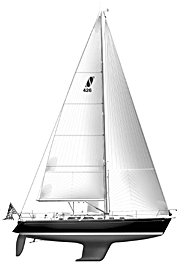Sabre 426
Performance cruiserr
I've always liked Jim Taylor's design work and I like this new Sabre model. Sabre has given us a long series of good all round boats that have always been attractive. I see several areas in this design where they have bucked current trends and I'd like to focus on those areas.
To begin, look at this bow. It's raked and while short in its overhang, it's not as truncated as we are used to seeing today. The real benefits of this type of bow is that it gets the ground tackle away from the stem so you don't bang the anchor against the boat when you are raising it. The raked bow also provides a little more flair to the bow, making the boat slightly dryer.
Of course you do give up a bit of sailing length forward with this type of bow. If we imagine this bow more close to plumb we could gain a theoretical additional 10 inches of DWL, bringing the DWL from 36 feet to 36 feet, 10 inches. Using a speed-to-length ratio of 1.34, this additional DWL would give us an additional .132 knots of theoretical hull speed.
The stern is certainly more narrow than we would see on a comparable French design. There is an elongated skeg forward of the rudder. I have not seen a skeg drawn out this far before. Structurally the skeg can be a big help in stiffening what would be a long flat panel. Another benefit of this long skeg is that it increases the builder's options of shaft angle and shaft log arrangement. This is a minor item on the surface but it can pay big dividends when it comes to designing the engine installation. The D/L is 230.
You have your choice of two keels. The deep draft keel draws 6 feet, 10 inches. The shoal draft keel is a winged-keel and draws 5 feet. The keel wings are swept and of relatively high aspect ratio. Short fat wings work as well as short fat keels. There is a small keel fin protrusion below the wings presumable to help protect the wings in case of grounding or setting on the hard.
All in all I think what we see when we look at the Sabre 426 hull is an intelligent amalgam of features that the builder has learned work well for pragmatic construction details in addition to providing the boat owner with a more user-friendly boat. The rig differs from the current crop of fractional rigs in that this one is a masthead rig. The three spreaders are slightly swept. The mainsheet is forward of midboom and will require a strong boom section to resist the bending moment imposed by this sheeting arrangement. Note that the mainsheet loads are spread out over three blocks to help with this load. I'd much rather see end-boom sheeting.
The SA/D is 17.7. This is not enough for blistering light air speed, but you won't have to reef when the wind gets to 18 knots either.
Jim Taylor designed the hull, appendages and rig for the 426. The rest of the design work was an in-house effort by Sabre's design team. For obvious reasons I'm partial to the outhouse approach, but in this case the Sabre designers have given the 426 a great interior layout. It's a two stateroom boat, so if there are more kids you will have to put them on the settees in the cabin for the night. I miss the days of pilot berths. I really like the symmetrically opposed settees, which make the saloon seem inviting and a comfy place to sit and go over the action of the day. The nav station is big as is the galley. This is a good example of the modern aft-cockpit interior layout. The focus is definitely on two-couple cruising.
It's interesting to watch the cross-pollination of Euro and American design trends. This clean looking Sabre gives us a Euro-style interior while maintaining the big lazarette aft. The hull and rig show details that have disappeared from most of the Euro boats. I find this a very interesting design.

Comments